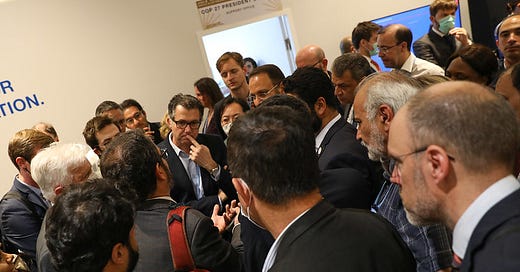Time to Deliver: What Makes a UN Climate Conference Worth Holding?
Diplomatic language. Long-overdue commitments. High hopes. Missing pieces. COP28 climate negotiations must be right around the corner.
With negotiations at the COP28 climate conference set to open in Dubai in less than two weeks, the annual flurry of agenda-setting, diplomatic meetings, deeply alarming reports, and glimmers of hope is in full swing.
And right on cue, we’re hearing the same question that comes up around every UN climate conference, in one of two flavours:
Is this the year when nearly three decades of plodding, process-bound climate negotiations will finally deliver results that make it all worthwhile?
And if not, how does this conference justify its carbon footprint?
We were at dinner with friends last night, and it took Greg about five seconds to put the COP in perspective. “Isn’t all that air travel a curious way to do something about climate change?” he asked.
It’s a question that wouldn’t have been out of place in the messaging guide for an anti-carbon tax rally…except that isn’t where it came from. Greg is a smart, resourceful engineer who spent his career taking on big, complex assignments and making them work (and not just because he’ll be reading these words). He’s deeply concerned about climate change. He knows better than most that a big, ambitious project only works when every available resource is devoted to making it work.
And there’s no project bigger or more ambitious than driving down global climate pollution by 45% this decade, then bringing it to net-zero by 2050.
Greg’s air travel question is one that everyone involved with the UN negotiating process should be asking—and the answer is easy enough to calculate.
The UN climate secretariat knows how many people are travelling for the conference, including their points of origin.
We can reliably assume that each delegate’s carbon footprint will be two or three times higher than their home lifestyle while they’re staying in a hotel, higher in a luxury suite.
(The hot air [pdf] generated in the meeting rooms is a different story, but we can get away without calculating that.)
So do the math, and the rest is a judgement call: Does this conference pull its weight if countries reach and implement decisions that save twice as much climate pollution as the gathering produced? Three times as much? Ten times as much? A hundred or a thousand times?
And at this point, less than two weeks before everything begins, how are they doing with that?
(Column continues below.)
Return of the Super-Emitters
The glimmer of hope last week was that the presidents of the world’s two highest-emitting countries, Xi Jinping of China and Joe Biden of the United States, agreed to restart cooperation on climate action. Their 25-point joint statement called for a tripling of global renewable energy capacity by 2030, explicitly as a substitute for fossil fuels. It committed both countries to implement their existing methane reduction plans, and lined up talks on methane and other non-CO2 greenhouse gases during COP28.
The statement contained no specific targets for energy efficiency improvements and no reference at all to a fossil fuel phaseout.
It’s important that the U.S. and China are talking climate again, after a year of frostier relations. But Climate Home News notes that China won’t be joining the 150 or so countries that signed on to a global methane pledge at the Glasgow COP, committing to a 30% reduction that already fell short of what climate science demands.
And the vagueness of the response from the world’s two super-emitters may not bode well for results at COP28, since “climate politics has an unwritten rule,” Climate Home writes: “Whatever the United States and China agree on sets the ceiling of ambition.”
But the fact that the two are talking—five days of discussions between lead negotiators Xie Zhenhua of China and John Kerry of the U.S., followed by the Biden-Xi meeting—is evoking memories of 2014, when a bilateral deal between the two countries set the stage for success at the Paris climate summit.
“We’re in a situation where countries are debating how to get out of COP28 with political language that calls on countries to triple renewable energy capacity, double energy efficiency, and also whether to call for countries to phase out fossil fuels, or unabated fossil fuels,” said veteran New York Times climate reporter Lisa Friedman. And “this definitely puts wind in the sails heading into COP.”
Programming note: You’ve no doubt been reading that tech giants Google and Facebook/Meta are blocking Canadian media from their news platforms. That makes email subscriptions to The Energy Mix and the Energy Mix Weekender your best antidote to make sure you always get the climate news you need. Subscribe today and never miss another edition!
Take Stock, Pick Up the Pace
Whenever I hear the term Global Stocktake, I can’t help imagining the world’s shopkeepers shutting their doors for a day to take inventory. But it’s actually something vastly more important, “a critical turning point when it comes to efforts to address climate change,” the UN climate secretariat writes.
When it convenes during COP28, the Stocktake will be “a moment to take a long, hard look at the state of our planet and chart a better course for the future,” the UNFCCC adds. “It enables countries and other stakeholders to see where they’re collectively making progress toward meeting the goals of the Paris Agreement—and where they’re not.”
After thousands of documents and hundreds of hours of talks, “the main technical conclusions emerging from the stocktake are not new. Nations are not cutting emissions fast enough, they are not sufficiently prepared for climate hazards, and developed countries are not providing enough support to developing countries,” Carbon Brief writes. “But the stocktake is more than just a review of progress. It is a key part of the Paris Agreement’s ‘ratchet mechanism’, which encourages countries to scale up their climate ambitions over time so as to avoid dangerous warming.”
While the Global Stocktake was a key element of the Paris climate agreement in 2015, many of the more recent climate pledges date back to the 2021 UN climate summit in Glasgow, where a series of “much-hyped promises” have produced very little so far, the Washington Post reports. “Deforestation remains rampant, pushing the Amazon rainforest toward a tipping point. Levels of methane in the atmosphere continue to set records. The planet just endured its hottest 12 months in the modern era, and probably the hottest in 125,000 years.”
Earlier this month, the UN-sponsored Production Gap report showed the world’s 20 biggest fossil fuel-producing countries on track to extract more than enough oil, gas, and coal in 2030 to defeat any hope of holding global warming to a relatively safe 1.5°C.
A key concern is that global climate investment, which stood at $1.3 trillion last year, falls short of the $8.6 trillion per year that will be needed this decade to get ahead of the climate emergency, increasing after that to $10 trillion per year through 2050, according to the non-profit Climate Policy Initiative (CPI). It’s also less than the $2.2 trillion that countries burn through for military spending each year, or the $7 trillion they devote to fossil fuel subsidies.
The annual figures add up to $266 trillion by mid-century, yet that total amounts to “pennies compared with the damage that will accumulate if we don’t make these investments,” notes Bloomberg columnist Mark Gongloff. The total cost of climate impacts and losses could add up to $2.3 quadrillion (2,300 trillion dollars, for the rest of us) by the year 2100, the CPI calculates.
With all these issues and many more rolled into the Global Stocktake, we’ll all know soon enough what conclusions the COP28 delegates reach, and how long it will take to translate even the best of words and intentions into action and results.
Silence or Greenwash: Pick One
With a resounding silence that kicks the prospect of a fossil fuel phaseout down the road, Biden and Xi are not alone. For months, the fossil fuel CEO who will be chairing COP28, Sultan al Jaber of the Abu Dhabi National Oil Company (ADNOC), has been trying to argue for reductions in oil and gas emissions that require no corresponding drop in oil and gas extraction.
That particular fantasy hinges on carbon capture and storage technology that won’t by ready for prime time by 2035, by the industry’s own admission, when climate science dictates a 45% reduction in global emissions by 2030.
But you can expect to hear a lot about a fossil fuel phaseout during the COP, even if 195 countries look unlikely to agree on the need or the timeline. The 27-member European Union and some other countries will be keeping it on the agenda, with initiatives like the Fossil Fuel Non-Proliferation Treaty showing up in Dubai to make the case. We’ll see how much more ground the fossil lobby can cover with hundreds of delegates flooding the zone during negotiations, and one of their own leading the whole process.
But this is one area where change is already happening—not yet fast enough, but still happening—whether or not negotiators can reach consensus on a watered down conference declaration. The International Energy Agency projects that demand for all fossil fuels will peak before 2030, then fall after that, and a separate analysis shows China’s world-leading emissions beginning their decline next year. So we may soon reach a point where a future COP might as well declare a phaseout target, since everyone knows it’s already happening.
Show Us the Money
Earlier this month, government negotiators finally reached tentative agreement on a loss and damage fund to compensate poor countries for the unavoidable impacts of climate change. And last week, the Organisation for Economic Co-operation and Development (OECD) announced preliminary figures indicating that rich countries had finally met their 2009 pledge to deliver US$100 billion per year in climate finance to the developing world.
The target date to assemble the funds was 2000, until the countries missed their own deadline.
The amount was one that they set themselves, not based on any measure of adequacy or consultation with developing nations.
And there are still concerns about the proportion of the funds that will arrive as outright grants, rather than loans that will eventually have to be repaid by the poorest nations to the richest.
Climate Home News points out that the $100-billion milestone is still “preliminary and unverified”, and shows how the whole model for international climate finance makes vulnerable people even more so when governments half a world away break their funding promises.
“For many, the lesson from the whole $100 billion fiasco is that developed countries won’t voluntarily take large sums of their taxpayers’ money and send it abroad,” writes Climate Home reporter Joe Lo. “The reaction of many climate justice campaigners is to keep denouncing them and keep the pressure on. Another strategy— arguably pragmatic, arguably defeatist—is to look for other sources.”
Lo cites Barbados President Mia Mottley’s Bridgetown Initiative as one example of an effort to “squeeze more money out of the World Bank and International Monetary Fund,” alongside an effort by France and Kenya to levy a new global tax to fund climate action. Those initiatives may be ready to take flight by the time COP30 convenes two years from now in Brazil—a wait that will feel like forever for communities on the front lines of the climate emergency, but barely a heartbeat on the time scale of international climate negotiations.
Is It Worth It?
All of which brings us back to Greg’s question last night, the same one that climate hawks and critics alike have been asking for years if not decades: Is it worth it?
COP28 delegates will be shaping their own answer in real time November 30-December 12. We’ll be telling the story every step of the way, and no doubt reporting on the mix of hope and frustration after negotiations wrap up.
But David Victor, a professor of public policy at the University of California at San Diego, told the Washington Post that 27 years of COP conferences have produced action and results that wouldn’t have happened without multilateral negotiations.
“I think it’s really important to distinguish between compliance with pledges and efforts” to meet them, he said. “You’ve got a lot of pledges that are ambitious and therefore require governments to do things they don’t know how to do. So they’re falling short, but they are making efforts.”
Mitchell Beer traces his background in renewable energy and energy efficiency back to 1977, in climate change to 1997. Now he and the rest of the Energy Mix team scan 1,200 news headlines a week to pull together The Energy Mix, The Energy Mix Weekender, and our two weekly e-digests, Cities & Communities and Heat & Power.
You can also bookmark our website for the latest news throughout the week.
Graph of the Week

Failed U.S. Nuclear Project Raises Cost Concerns for Canadian SMR Development
EV Battery Prices to Fall 40% by 2025, Goldman Sachs Predicts
46M Health Professionals Urge Fossil Phaseout as Lancet Countdown Warns of Dire Impacts
Trudeau Applauds Canada’s First City-Wide Smart Grid
China’s Emissions Will Begin to Decline in 2024
NYC’s Non-Profit Cleantech Lab Boasts 88% Success Rate
NS Writers Scorch Alberta Govt ‘Snake Oil’ While Analysts Cite Gas as ‘Dying Commodity’
Ontario Asks for More Time, Flexibility on Clean Electricity Regs
Ontario Health Workers Push Pension Fund to Divest Fossil Fuels by 2025
Alberta’s new ‘Tell the Feds’ ads are a naked ploy to unyieldingly serve Big Oil: Olszynski (Globe and Mail)
Alberta gives hint of changes to follow renewables pause (Globe and Mail)
Majority of Canadians support the creation of a Youth Climate Corps, new polling reveals (Climate Emergency Unit)
EV battery subsidy deals to cost $5.8B more than government projections, PBO report says (The Canadian Press)
Ford’s Tories table law cancelling municipal boundary changes in wake of Greenbelt scandal (Toronto Star)
Judge says Ottawa listing plastic items as toxic was ‘unreasonable and unconstitutional’ (Canadian Broadcasting Corporation)
Plastic’s life cycle costs overwhelmingly fall on poor countries (Grist)
How Biden’s landmark climate law is transforming a small South Carolina town (Financial Times)
Why these industrial giants are betting on the transition to clean energy (CNBC)
Oil major BP seeks partnerships to navigate renewables storm (Reuters)
Environmental groups urge funding halt for TotalÉnergies’ Mozambique project (Reuters)
Corruption and Rights Abuses Are Flourishing in Lithium Mining Across Africa (Inside Climate News)








